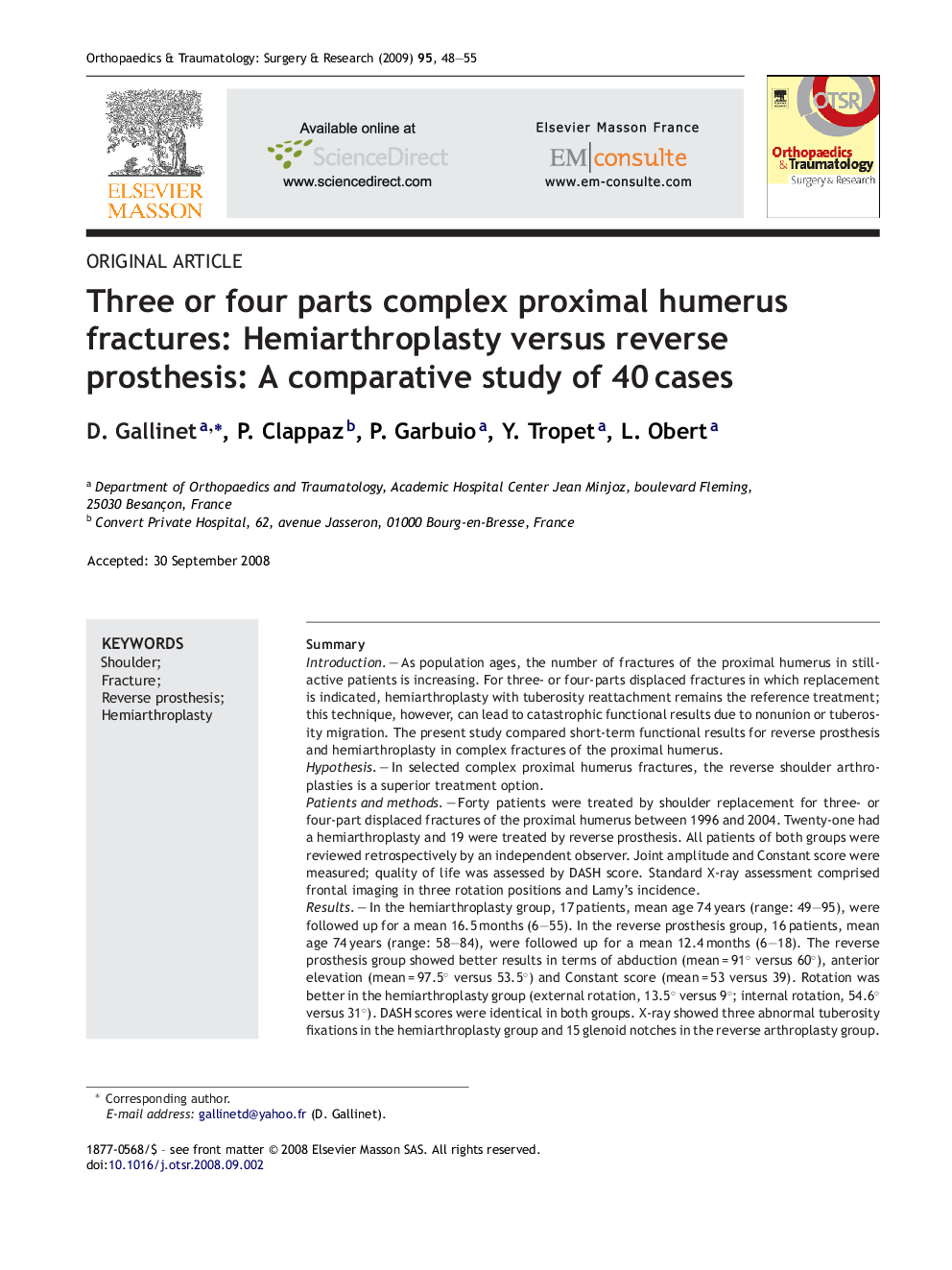| کد مقاله | کد نشریه | سال انتشار | مقاله انگلیسی | نسخه تمام متن |
|---|---|---|---|---|
| 4082640 | 1267649 | 2009 | 8 صفحه PDF | دانلود رایگان |

SummaryIntroductionAs population ages, the number of fractures of the proximal humerus in still-active patients is increasing. For three- or four-parts displaced fractures in which replacement is indicated, hemiarthroplasty with tuberosity reattachment remains the reference treatment; this technique, however, can lead to catastrophic functional results due to nonunion or tuberosity migration. The present study compared short-term functional results for reverse prosthesis and hemiarthroplasty in complex fractures of the proximal humerus.HypothesisIn selected complex proximal humerus fractures, the reverse shoulder arthroplasties is a superior treatment option.Patients and methodsForty patients were treated by shoulder replacement for three- or four-part displaced fractures of the proximal humerus between 1996 and 2004. Twenty-one had a hemiarthroplasty and 19 were treated by reverse prosthesis. All patients of both groups were reviewed retrospectively by an independent observer. Joint amplitude and Constant score were measured; quality of life was assessed by DASH score. Standard X-ray assessment comprised frontal imaging in three rotation positions and Lamy's incidence.ResultsIn the hemiarthroplasty group, 17 patients, mean age 74 years (range: 49–95), were followed up for a mean 16.5 months (6–55). In the reverse prosthesis group, 16 patients, mean age 74 years (range: 58–84), were followed up for a mean 12.4 months (6–18). The reverse prosthesis group showed better results in terms of abduction (mean = 91° versus 60°), anterior elevation (mean = 97.5° versus 53.5°) and Constant score (mean = 53 versus 39). Rotation was better in the hemiarthroplasty group (external rotation, 13.5° versus 9°; internal rotation, 54.6° versus 31°). DASH scores were identical in both groups. X-ray showed three abnormal tuberosity fixations in the hemiarthroplasty group and 15 glenoid notches in the reverse arthroplasty group.DiscussionIn three- or four-part displaced proximal humerus fracture, arthroplasty does not ensure recovery of pretrauma shoulder function. Management is therefore to be decided in terms of outcome predictability and rapid recovery of daily comfort for elderly patients. Hemiarthroplasty can provide good functional results, but depends on tuberosity union quality and this often necessitates a prolonged immobilization. Reverse prostheses provide reliable, rapid and predictable results in terms of abduction, anterior elevation and pain relief, but impaired rotation; this impacts quality of life and long-term implant durability (glenoid notching). Reverse prostheses should thus prove advantageous in the treatment of complex fractures of the proximal humerus if these two drawbacks can be resolved and at present seem indicated on condition that the patient is no younger than 70 years of age.Level of evidence: level IV; therapeutic study.
Journal: Orthopaedics & Traumatology: Surgery & Research - Volume 95, Issue 1, February 2009, Pages 48–55